Spain’s Grocery Stores & Supermarkets – What to Know
Written by Nadia Podrabinek
Hello, my name is Nadia. I usually write about traveling (there are so many places to fit all the lifestyles), relocation, and living in a foreign country (adapting to a different culture). My travels stretch beyond Spain, with journeys to the US, Italy, Norway, Portugal, and France. Relocating to Spain in 2018, I lived in cities from Barcelona to Madrid, currently calling Valencia home. Follow me on Twitter, Facebook, Instagram, or LinkedIn! ... show more
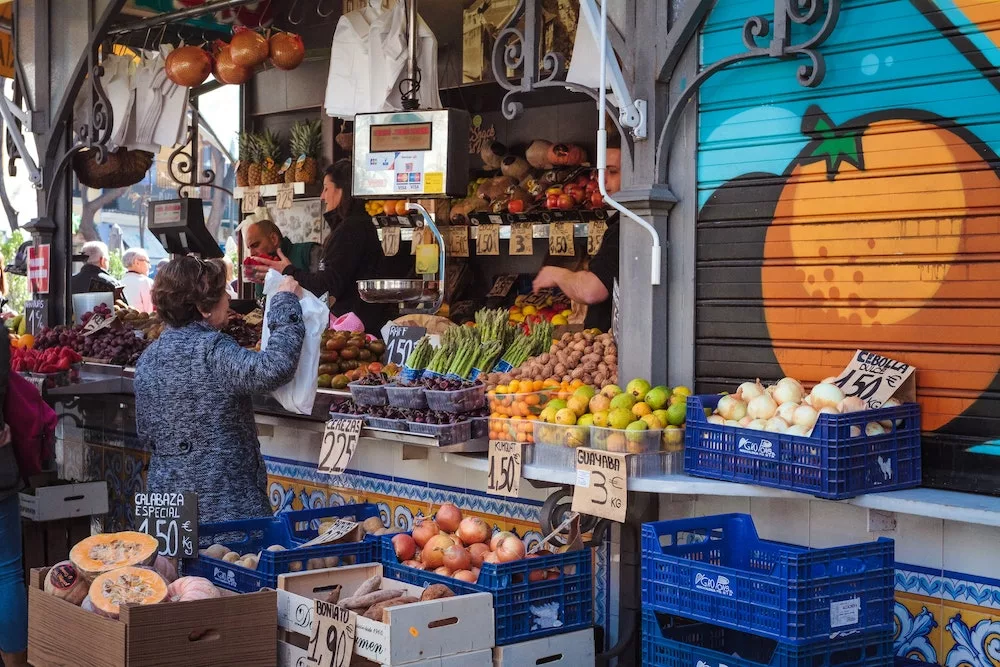
Is discussing supermarkets and grocery stores in Spain not that fascinating? Correct, it is not.
However, before you travel to Spain, it is good to know the specifics of local supermarkets, and some other differences to make your trip not totally dependent on restaurants.
Many people are asking about groceries in Spain on Facebook, Reddit, etc., so I made this comprehensive guide that should help you budget when shopping for items from local markets while visiting Spain.
What people say on Reddit
I don’t know what the data is based on but the general impression I’ve had for years throughout all of the country is that it’s Mercadona/Eroski, Carrefour, Lidl/Aldi in that order. I personally find Mercadona to be worthy of being called one of the most reputable companies.
shaisnail
Consum is way better than Mercadona. But Juan Roig has upped his game on packaging and new products in the last few years. Ten years sgo Mercadona sucked hard
Haru_omoi
We only buy a couple packages of meat a week now & eat far more vegetables. Cuts the cost of shopping in half with less meat. Still shop at Mercadona, Lidl or Carrefour as they are local, however have found cooking in batches helps saves some money and time.
CherrieBlo
Agree on Bon Area! Lidl and Aldi for none meat stuff, Dia has some decent diary that’s cheap. Why anybody shops in Mercadona still amazes me, its all sh1te and any meat is fucking rank and full of water, plus the guy who owns it a fascist lol.
la sirena for frozen fish and other frozen veg stuff.
ourmanflint27
Guide to Spain’s Grocery Stores
Although there are more than 30 chains of groceries in Spain, I will only mention the most popular ones that you will see almost everywhere in the country.
Here is the list of the best groceries in Spain (according to The Spanish Consumers and Users Organization, OCU).
The assessment is based on criteria such as proximity, cleanliness, variety of products and brands, staff attention, prices, quality of fresh produce, and waiting time at the cash register, among others.
Best Spanish Supermarket Chains
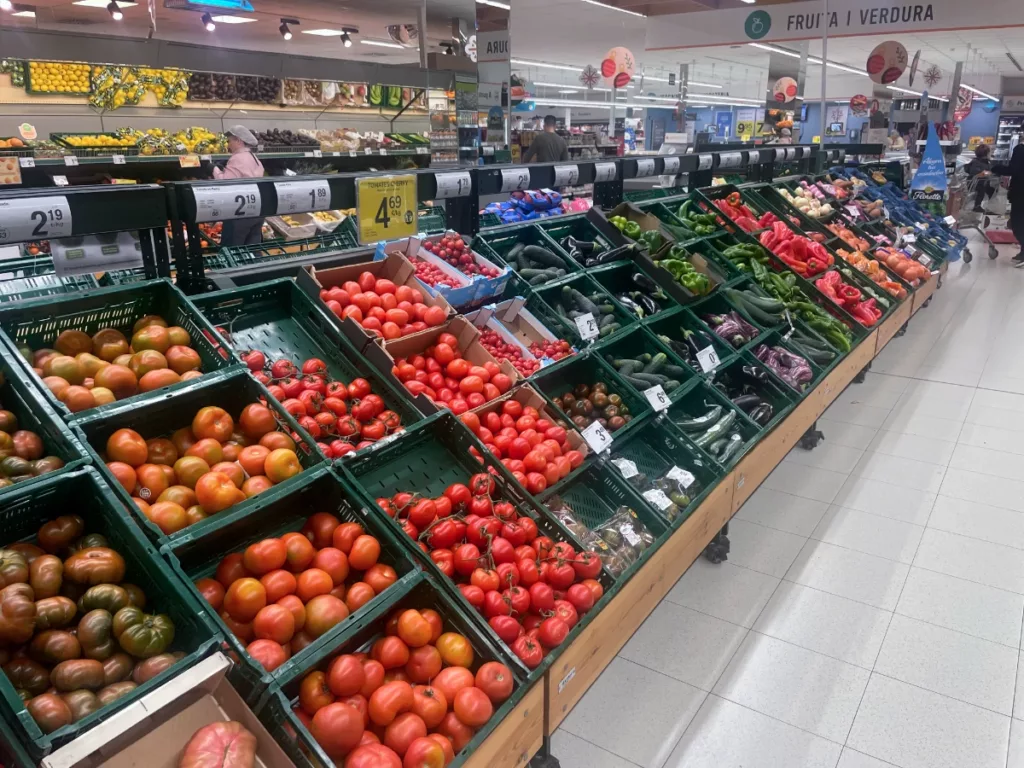
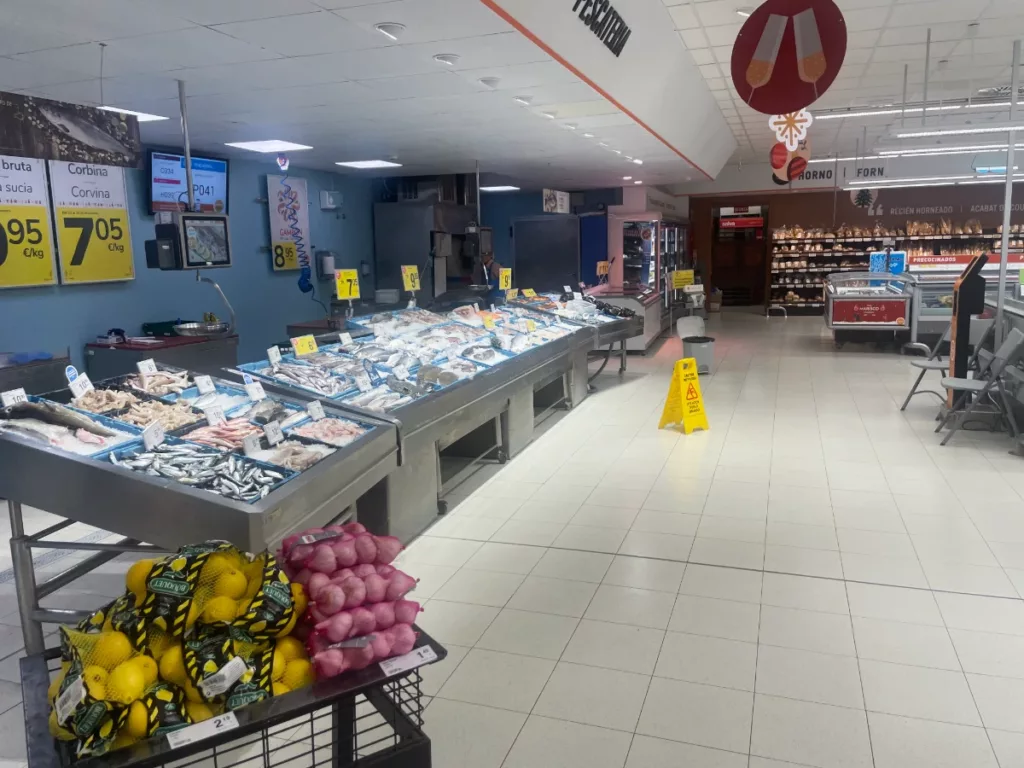
- Eclat, Bon Preu (Barcelona/Catalonia)
- Hipercor
- El Corte Inglés
- Aldi
- Consum
- Alcampo
- Supercor
- Lidl
- Eroski
- Mercadona
- Carrefour
This is a brief overview of the different grocery stores and my favorites among them.
1. Mercadona
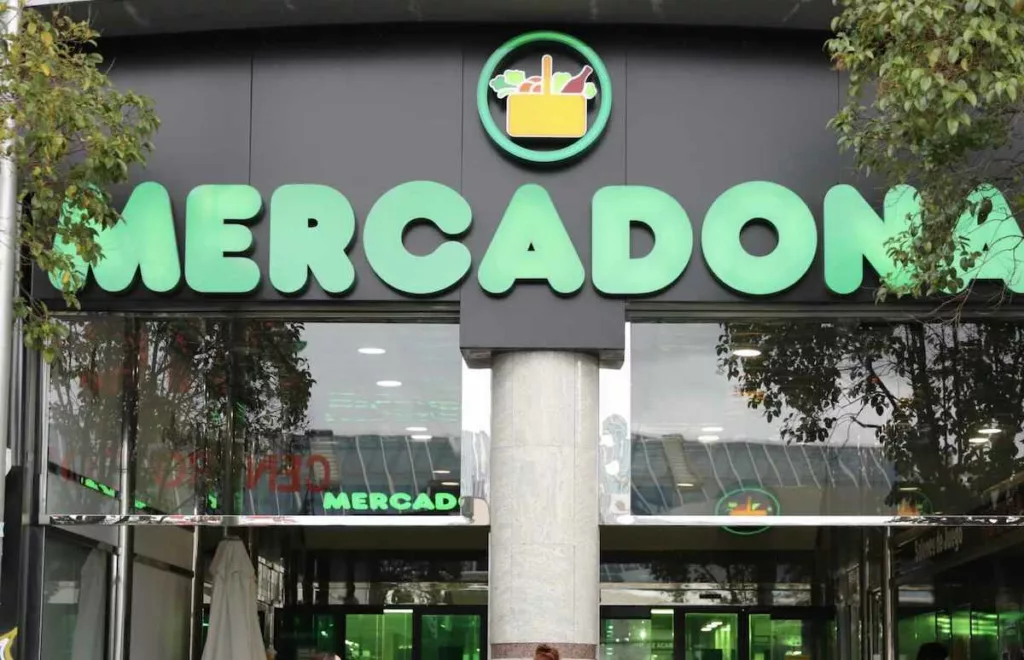
In my experience, it is the most convenient and well-rounded grocery store in all of Spain. Basically, you will find these grocery stores everywhere – the retailer occupies 1/5 of the entire food market in the country.
They offer many traditional Spanish products, and there is a section where you can choose fish and other seafood from the counter, just like at the market. Your purchase will be washed, cleaned, and fully prepared for cooking, and you will get advice on the best way to cook it. The same applies to the meat department.
In Mercadona, you will find lactose free, gluten free and vegan products as well.
They also offer ready-made food, such as salads, sushi, poke bowls, paella, etc. Check out their “Black Angus burger!”
2. El Corte Ingles
El Corte Ingles grocery, as well as Hipercor and Supercor (its branches), offer a great variety of quality products, but they are by far the most expensive supermarket out there. And very similar to the Wholefoods/Trader’s Joe.
You’ll find goods you can’t get anywhere else, from ostrich eggs to spaghetti made of chestnuts and other delicacies.
3. Consum
Consum is a large grocery chain across Spain, and I call it “a cheaper version of Mercadona.” It offers almost everything you may want from Spanish groceries, including pre-made food. Unfortunately, I am not always happy with their chicken and meat products. Maybe I’m just used to buying organic chicken.
4. Lidl
Lidl is a German supermarket chain widely available in Spain. Usually, they don’t offer many products, but their bakery is quite good and they have lots of European products and quite a range of vegan stuff!
5. Carrefour
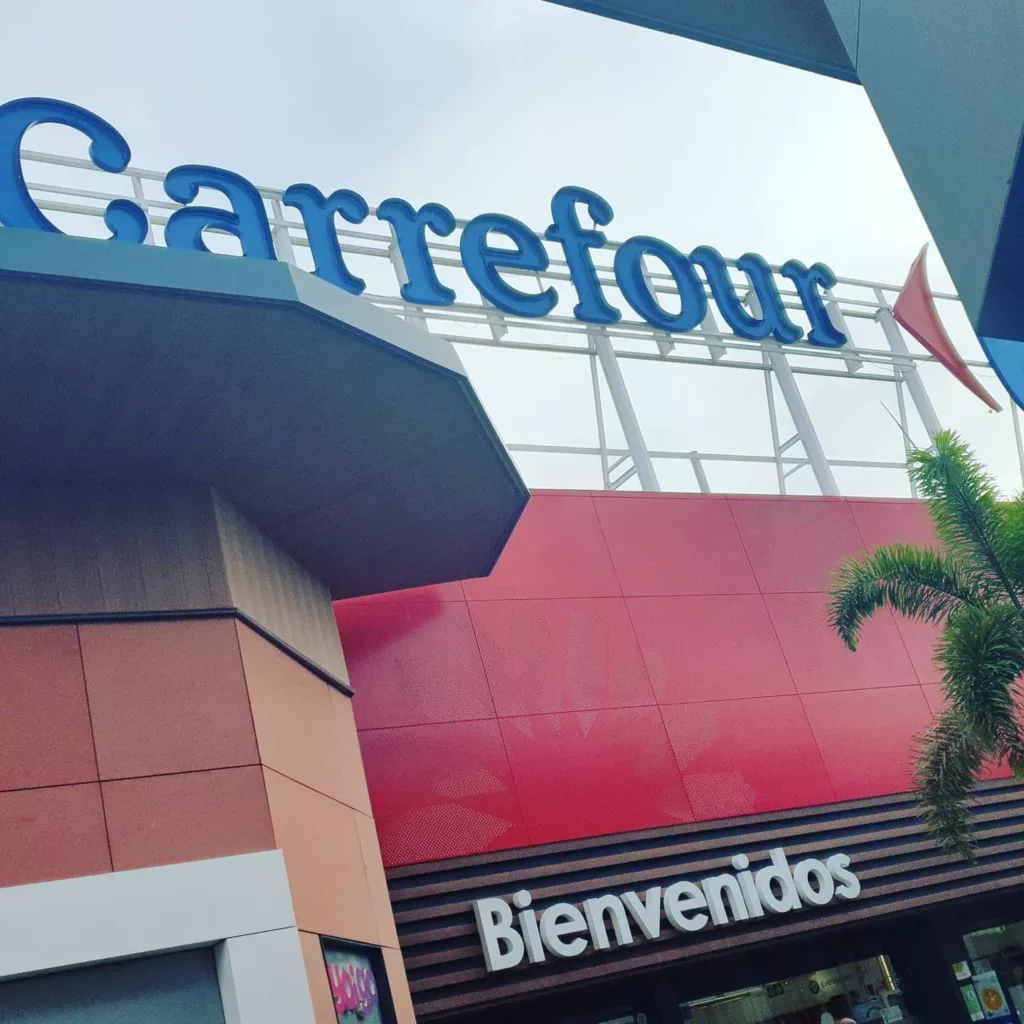
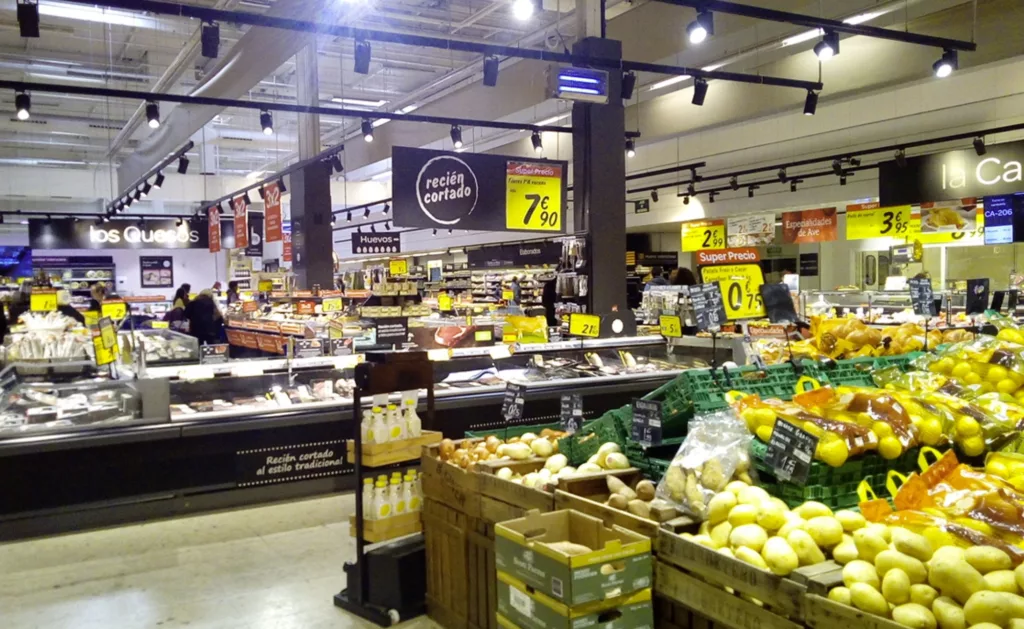
Carrefour is an international chain of French origin, offering reasonable prices, which are almost on par with Mercadona. In larger cities, Carrefour has departments with appliances and household items.
6. Alcampo
This is a cheaper version of Carrefour and is usually located on the outskirts.
7. Eclat
Eclat is a chain of grocery stores located throughout Catalonia, Spain.
The company was founded in 1984 and has since grown to become one of the leading food retailers in the region.
Eclat currently operates more than 65 supermarkets, offering customers a wide variety of fresh produce, meats, seafood, and prepared foods.
In addition to its supermarket locations, Eclat also runs several specialty stores that focus on organic products or gourmet cuisine from around the world.
By the way, the average monthly grocery bill in Spain is €369 per month, excluding purchases in other stores.
The cheapest groceries
| Grocery store | Average yearly bill |
| Tifer | €4,890 |
| Dani | €4,912 |
| Family Cash | €4,990 |
| Alcampo | €5,006 |
| Supeco | €5,014 |
| Familia | €5,102 |
| Cash Fresh | €5,104 |
| Deza | €5,120 |
| Sangüi | €5,120 |
| El jamón | €5,208 |
Opening hours
While many clothing stores around the country close during midday for a siesta break, grocery stores usually open from 9 am to 9:30 pm.
It is important to know that all Spanish grocery stores are closed on Sundays (except for Carrefour and Carreforu Plus).
If you struggle with buying food on Sunday, you will probably find something to eat in the small convenience stores on the streets (usually owned by those of Indian and Chinese people).
What are the Food Prices?
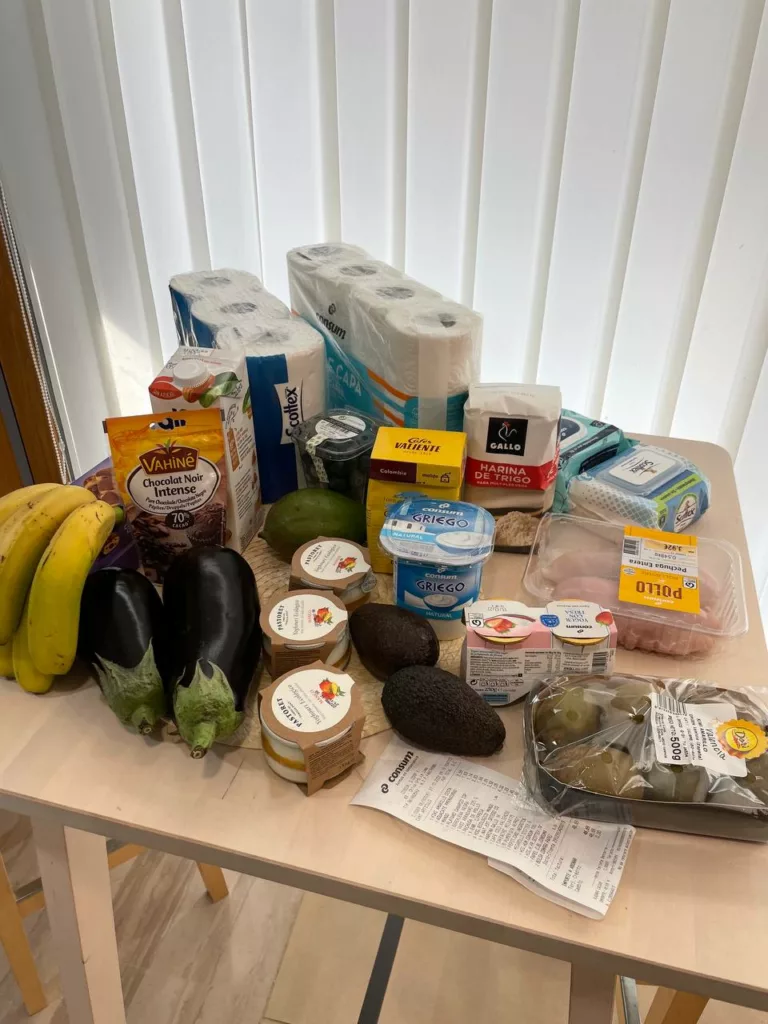
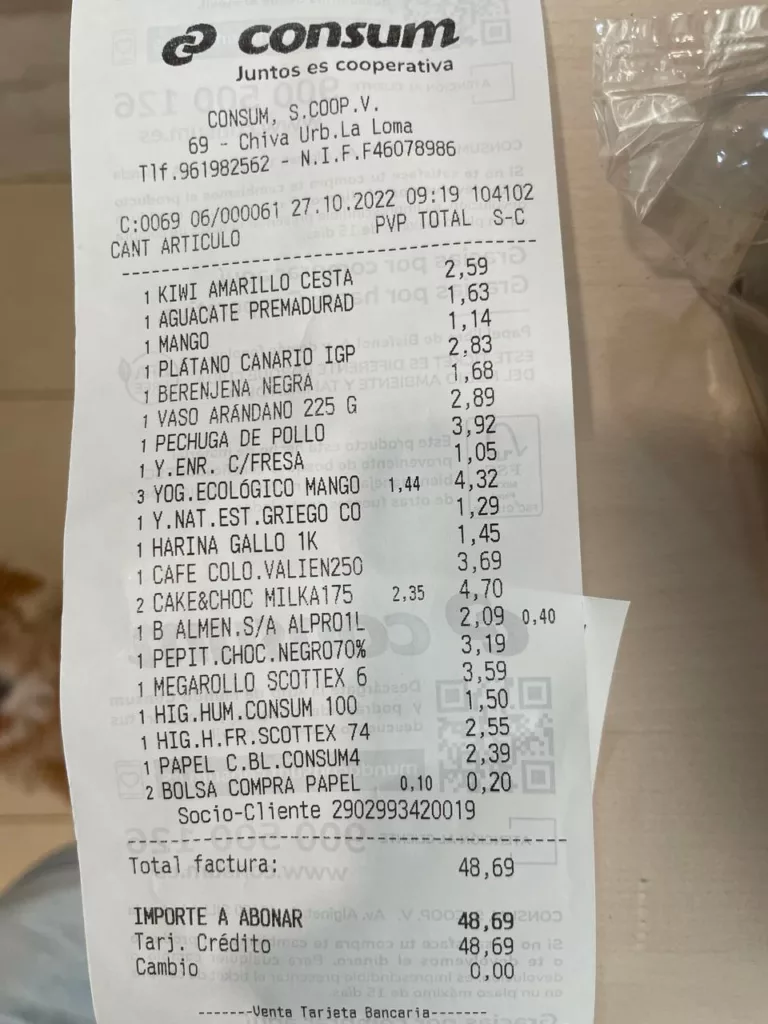
| Product | Quantity | Price, € |
| Kiwi | 6 | 2,59 |
| Avocado | 2 | 1,63 |
| Mango | 1 | 1,14 |
| Banana (Canary islands) | 6 | 2,83 |
| Eggplant | 2 | 1,68 |
| Blueberries | 225g | 2,89 |
| Chicken breast | 2 | 3,92 |
| Greek Yogurt | 1 | 1,29 |
| Flour | 1kg | 1,45 |
| Ground coffee | 250g | 3,69 |
| Cookies | 1 | 2,35 |
| Toilet paper | 6 | 3,59 |
| Paper bag | 1 | 0,10 |
What to Budget for Food in Spain
The average bill for two in the Spanish grocery is about €35-50 (assuming you buy fruit, vegetables, meat or fish, etc.)
The cost eating out in Spain varies greatly depending on where you are and what type of cuisine you prefer.
Generally, budget travelers should expect to spend between €30-€40 day for meals, while mid-range travelers can expect to pay around €40-€60.
Read also: Popular Spanish snacks & tapas
Tips for Saving
There is not that big of a difference compared to other countries:
- Take advantage of discount stores: Some grocery stores offer discounts, such as Aldi or Lidl.
- Stick to seasonal produce: Fruits and vegetables are more affordable when they’re in season.
- Make use of leftovers.
- Look out for promotions & coupons.
Is It Worth Buying Ready-Made Food in Spain?
It depends on your individual needs and preferences. Ready-made food in Spain can be convenient for some, but it may not always offer the best value or quality compared to home cooking.
Pro tip Buy sushi and poke bowls at Mercadona. They are always fresh and tasty!
Convenience Stores at Gas Stations
Typically, they sell sweets, drinks, and bakery products. You can often find a big gas station with a store and a restaurant. In this case, the store is combined with the eatery.
Honestly, there is no significant difference between a gas station store in the US and Spain. Grab some fresh bread or croissant if you come there in the morning.
Regional Specialities to Try in Spain
Barcelona
The regional specialties to try in Catalonia include the traditional Catalan dish called pa amb tomàquet (bread with tomato), esqueixada (shredded salt cod salad), escalivada (smoky roasted vegetables), and crema catalana (a custard-style dessert).
Valencia
You should definitely try paella Valenciana, fideuà, or arroz negro (rice made with squid ink and seafood), and drink their famous horchata (made from tiger nuts).
Madrid
Try cocido madrileño (stew cooked over low heat for hours until it thickens), callos a la Madrileña (tripe simmered slowly with sausage), sopa de ajo (garlic soup).
Galicia
When traveling through Galicia, be sure to enjoy its signature dishes such as pulpo á feira (octopus boiled + seasoned with smoked paprika, salt, olive oil, etc.), percebes (goose barnacles steamed briefly before serving them up hot right off the shell), and tarta Santiago (almond cake).
The Basque Country
Pintxos! These small bite-sized snacks are typically eaten at bars/pubs in any Basque town.
Organic food / Wholefoods
If you are used to shopping at Whole Foods, you may wonder what the equivalent is in Spain.
I have to tell you now – European food is much higher quality than the US, so there is no need for something like Whole Foods.
You can find healthy products for more reasonable cost in Spain, that’s for sure.
Read also: Is there Wholefoods in Spain?
So, it does not matter that much – almost every grocery store in Spain has many more healthy products than in the US, with many organic choices and specialty items like gluten-free bread and vegan snacks.
Also, Spain adheres to strict European Union regulations on food additives: Spanish-made bread, cookies, soda, and other processed foods are free of many potential cancer-causing ingredients found in American products.
Essential Supermarket Phrases, Vocabulary
Here is the common grocery store vocabulary. You can always back off saying “No hablo Español” (Noh ah-bloh Ehs-pah-ny’ohl):
- La pescadería – Fish
- La carnicería – Butcher products
- La panadería – Bakery
- Higiene – Hygiene
- Los electrodomésticos – Electric Appliances
- “Disculpe, ¿dónde está {product name}?” – “Excuse me, where is the {product name}?”
- Caja – The cash register
- “¿Bolsa quiere?” – “Do you need a bag?” (a cashier usually asks at the cash register)
- “Sí, una/dos/tres bolsas, por favor” – “Yes, one/two/three bags please”
- “Perdóna, ya no hablo Español” – “I am sorry, I don’t speak Spanish”
When is the Best Time to Visit Spain?
April and October are the best time to visit Spain for a food experience. This is when many local festivals and traditional celebrations occur throughout the country, allowing you to try regional dishes that may not usually be available at other times of the year.
Additionally, this period offers mild temperatures, allowing you to enjoy outdoor dining experiences without feeling too hot or cold.
Best Things to do in Spain
Since this is a post about the foods, I’d suggest some culinary experiences to try:
- Take a Tapas Tour in Barcelona
- Indulge in Paella in Valencia
- Taste Manchego Cheese from La Mancha region
- Enjoy Churros with Hot Chocolate for breakfast
- Savour Pintxos and Basque Cuisine in San Sebastian
- Try the Spanish Tortilla, Patatas Bravas & Jamon Iberico
- Sample the famous Seafood dishes on Costa del Sol beaches
- Eat Pulpo Gallego (Galician Octopus)
- Discover different wines of Spain’s various regions, e.g Rioja red wine
Is Spain Expensive?
Spain is generally considered to be an affordable destination for travelers. Prices vary depending on the region and city.
Popular destinations like Barcelona and Madrid are more expensive than smaller cities or rural areas.
That said, Spain remains a relatively good value compared to other European countries. It offers plenty of budget-friendly options for food, accommodation, transportation, and activities.
FAQs
To replace your sugar/cream combination, try “leche condensada.” For American coffee and iced coffee, as well as cooking purposes, “nata” (heavy cream) is what works best for me. As for morning coffee, Mercadona’s goat milk does nicely! Feel free to try out different local products – something might suit your tastes better than anything else!
You should always pay in the local currency (euros), which allows your bank to set the exchange rate, and it will always be a better option. If you choose to pay in dollars, you get the worst exchange rate from the merchant.
My very rough estimation for Spain stores:
Al Campo = Walmart on steroids.
Carrefour = Target.
El Corte Ingles = Nordstrom/Macy’s/Saks.
You may also want to got to the “bazaars” (also known as the “Chinos”, because they are largely owned by Chinese families).
Yes, it is quite efficient. They have even begun delivering on Sundays, which is very surprising. The only downside is that they don’t group items together so you will receive multiple boxes. It can also be convenient to have Amazon Prime (but this may be more important for a longer stay).
You can find peanut butter at Mercadona or Consum. It is called “Crema de cacahuete.”

3 replies on “Spain’s Grocery Stores & Supermarkets – What to Know”
Just moved to Valencia. Your store comparisons to each other and US stores is very helpful. also the list of phrases for the grocery store is great. Thank you for putting this together.
This is a great list! However, I must preface that El Corte Ingles is more like Whole Foods, and Lild is more like Trader Joe’s as it’s more of an economic/budget grocer.
Thank your for reading and for sharing your thoughts, Valerie. 🙂